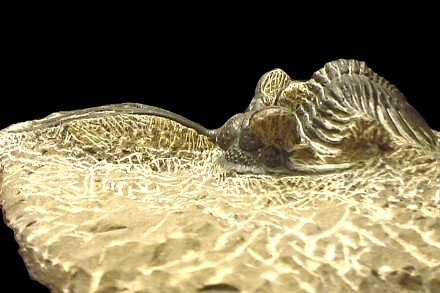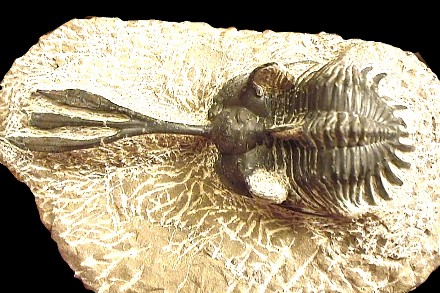Walliserops trifurcatus
Here is a new Asteropygina of the Morocan Devonian described by P. Morzadec
in 2001. Currently, this is a monospecific genus, so the diagnosis of the genus
and the species are similar.
On the web, you can find this trilobite named Comura trident, Walliserops
trident.
| 2001 |
Walliserops trifurcatus |
nov. sp., MORZADEC 2001,
p.77 - 78, planche 14, fig. 1 - 2. |
|
|
Specimen description :
|
|
Lateral view of the specimen.
|
|
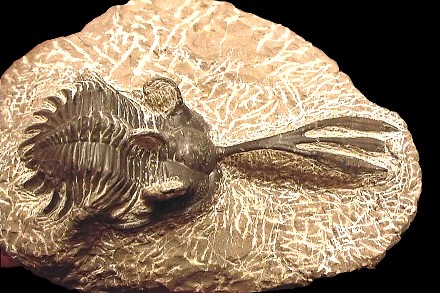
|
|
Slightly oblique view.
|
|
|
|
Dorsal view of the specimen.
|
Diagnosis :
|
Order
|
Phacopida
|
SALTER 1864
|
Occurrence: Lower Ordovician (Tremadoc) to Upper Devonian (Famennian).
- Cephalon: Proparian (Phacopina and Cheirurina), gonatoparian
(Calymenina) or opisthoparian (Calymenina),
- Preglabellar field often very short or absent.
- 4 or fewer pairs of glabellar furrows.
- Eyes : when present, schizochroal (Phacopina) or holochroal (Cheirurina
and Calymenina).
- With rostral plates (Calymenina and Cheirurina) or without (some
Phacopina).
- Hypostome conterminant (all suborders) to impendent (some devonian
Phacopina).
- Exosqueletton generally granulous.
- Thorax: 8 – 19 segments, sometimes distinctly furrowed.
- Axis sometimes broad (e.g., Homalonotidae).
- Pygidium : Typically micropygous (most Calymenina and Phacopina),
but variable (e.g., subisopygous in Dalmanitoidea and Acastoidea).
- May be lobed or spiny (e.g., Cheirurina, some Dalmanitoidea, Acastoidea),
or smooth-margined, with round or subtriangular outline (e.g., Calymenina,
Phacopoidea).
|
|
Sub-order
|
Phacopina
|
STRUVE 1959
|
- Cephalon : Proparian sutures (sometimes fused).
- Schizochroal eyes.
- Glabella expands forwards.
- Librigena typically yoked as single piece.
- Hypostome conterminant to impendent, some with no rostral plate.
- Some with genal spines.
- Thorax: 10 to (typically) 11 segments.
- Pleurae furrowed, articulating facets distinct.
- Rounded, angular, or spinose tips.
- Pygidium : Typically smaller than cephalon (but subisopygous
in Dalmanitoidea and Acastoidea).
- Smooth or spinose.
|
|
Super-family
|
Acastoiedea
|
DELO 1935
|
- Cephalon : Axial furrows slightly to moderately divergent.
- Anterior glabellar lobes and furrows usually not fused (although furrows
may be indistinct).
- Eyes typically distant from posterior border furrows, but not strongly
anterior.
- Frontal glabellar lobe auxilliary impression system triangular in
outline.
- Maximum width of glabella adjacent to preglabellar furrow.
- Median region of glabella devoid of muscle scars.
- Cephalic margin "shouldered".
- Laterally convex course of genal margin topographically distinct from
curvature of axial margin.
- Thorax : Pleural endings blunt, rounded or angular.
- Sometimes spinose.
- Pygidium : Micropygous to subisopygous.
- Sometimes spinose (expressed as marginal spines).
- Pygidial axis with deep, apodemal anterior ring furrows, with abrupt
transition to shallow posterior ring furrows.
- Coincident decrease in angle of axial furrow convergence.
|
|
Family
|
Acastidae
|
EDGECOMBE 1993
|
- Cephalon : Semi-circular to rounded subtriangular.
- Cephalic border narrow in front of the glabella.
- Dorsal furrows slilghtly to moderately divergent.
- Anterior glabellar furrows (S3) simple.
- Medial furrows (S2) moderately deep.
- Deep posterior furrows (S1).
- L2 and L3 lateral glabellar lobes generally fused distally.
- Muscle scars bearing sometimes callosities (Acastinae).
- Eyes typically distant from the posterior genal furrows.
- Hypostoma
- Pygidium : micropygous to subisopygous.
- Semi-circular to rounded subtriangular.
- Short posterior spine present.
|
|
Sub-family
|
Asteropyginae |
DELO 1935
|
Traditionnally included in the Dalmanitidae, Asteropyginae are now included
in the Acastids. Mostly benthic trilobites.
- Cephalon : Closely similar to the Dalamanatid Dalmanitides
BARRANDE 1853.
- Glabella expanding forward.
- 3 lateral glabellar furrows.
- Eyes generally large.
- Genal angles acutely pointed or bearing medium-length to very long
genal spines in straight continuation of lateral margins.
- Pygidium : Rachis never reaching the posterior region of the
pygidial border.
- Generally 5 pairs of lateral spines (sometimes 4 or 6).
- Unpaired posterior lappet or spine.
|
|
Genus
|
Walliserops
|
MORZADEC 2001
|
- Cephalon : Very long median spine, trifurcated in 3 tongue-like
projections.
- Palpebral spines.
- Metafixigenal spines.
- Long occipital spine.
- Ocular peaks.
- Thorax : First two thoracic segments without axial spines.
- Pygidium : 7 bent axial rings, spine-bearing.
- 5 pairs of pleural ribs on the pleuræ.
- cometa-type segmentation.
- 5 pairs of pygidial lateral spines careened and strip-shaped.
- Pygidial median spines shorter than the lateral pairs.
|
|
Species
|
trifurcatus
|
MORZADEC 2001
|
see genus diagnosis (monospecific). |
Discussion :
Complete description of Walliserops trifurcatus (After MORZADEC
2001) :
- Cephalon : Flat and smooth margin which widens in its latero-anterior
parts and which ends at the glabella.
- Frontal lobe of the glabella is prolonged anteriorly by a very long median
spine whose length is greater than 1.5 times that of the cephalon.
- Anterior spine sub-circular and directed upwards in its proximale part,
flat and horizontal in the distal part. At the distal end, the spine trifurcates
in 3 careened strips at their proximal part, flat at their distal end.
- Dorsal furrows not very divergent.
- One pair of metafixigenal spines, 1 pair of long and arched palpebral spines,
1 strong, backward arched, occipital spine.
- Fine genal spines, reaching in length the level of the 5th thoracic segment.
- Ocular areas : 27 dorso-ventral files of with a maximum of 9 lenses per
file.
- Eyes joined together with the glabella by ocular peaks.
- Lateral parts of the frontal lobe of the glabella, the lobes L3, the free
cheeks and the fixed cheeks decorated by large tubercles
- Thorax : 11 thoracic segments.
- Axial rings, except the two first, having a strongly bent median spine
- Vertical spine at their distal end of the pleuræ.
- Pygidium : 7 axial rings bent backwards.
- Median axial spine.
- 5 pairs of pleural ribs, the 5th pair being reduced to a half-rib.
- Pleural furrows broad.
- Anterior half-ribs are slightly broader and more in relief that the posterior
ones, carrying a tilted vertical spine bent backwards at their distal extremity.
- Vertical spines decreasing in size posteriorly and hardly visible on the
fifth pair of ribs.
- Lateral marginal spines in the shape of a narrow strip, bent posteriorly,
careened on their base, flat at their distal end.
- Median spine, slightly careened, is shorter than the lateral ones.
Complementary pictures :
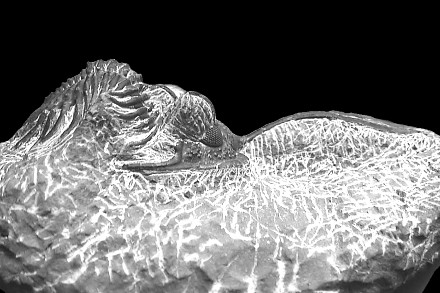 |
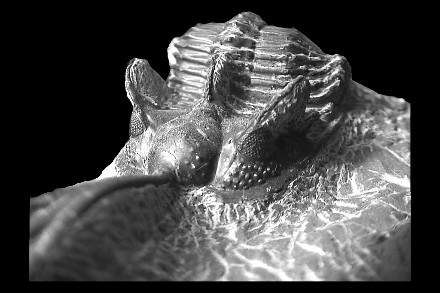 |
|
Full specimen, right side view.
|
Glabella and eyes.
|
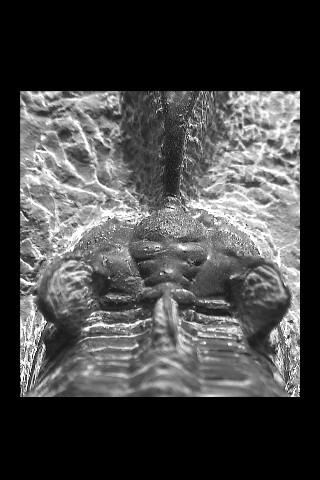 |
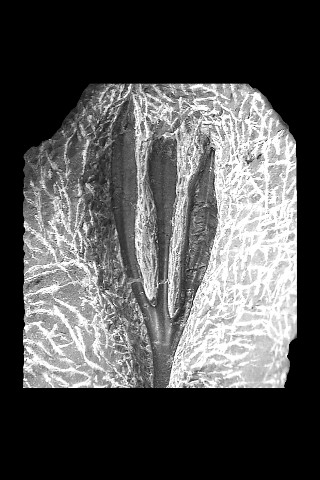 |
|
Study of the granulation.
|
The trifurcation of the medial cephalic spine.
|
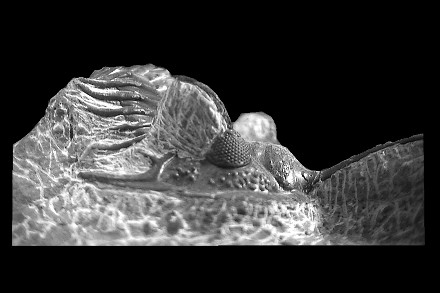 |
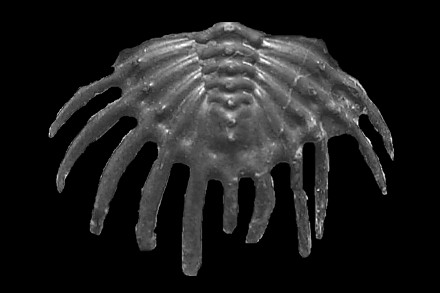 |
|
Right eye.
|
Dorsal view of the pygidium.
|
Specimens seen on the web :
Spécimen n°1 :
A nice specimen presented by Aziz at the 25. Internationale Börse für Mineralien,
Fossilien, Edelsteine und Schmuck of Hamburg (Dec. 2002)
(link : www.trilobiten.de)
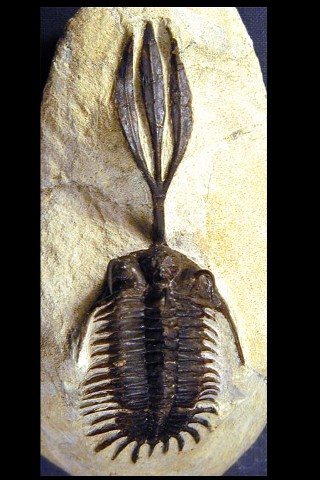 |
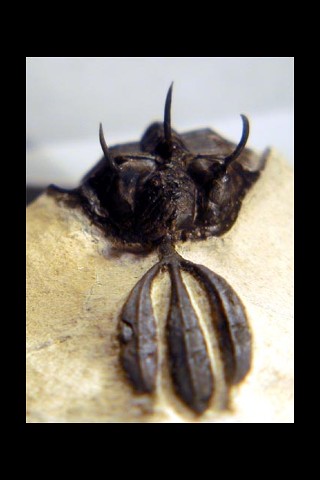 |
|
Dorsal view of the specimen
|
Frontal view.
|
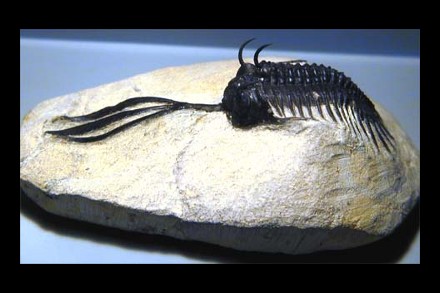 |
|
Side view.
|
Specimen n°2 : supremely spiny...
To see at www.paleodirect.com ...
 |
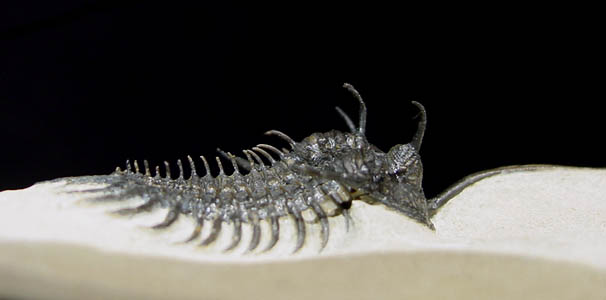 |
|
Dorsal view of the specimen
|
Side view.
|
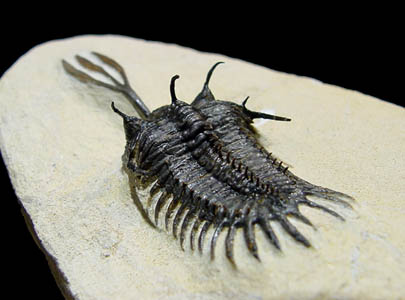 |
|
Oblique lateral view
|
References :
MORZADEC P. 2001. Les Trilobites Asteropyginae du Dévonien
de l'Anti-Atlas (Maroc) [Asteropyginae Trilobites from the Devonian of the Anti-Atlas
(Morocco)]. Paleontograph. Abt. A 262 (1/3) : pp 53 - 85.
Back
to Home Page
